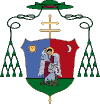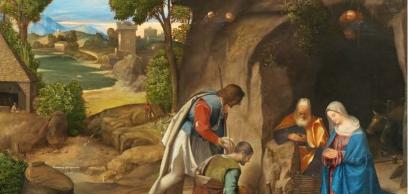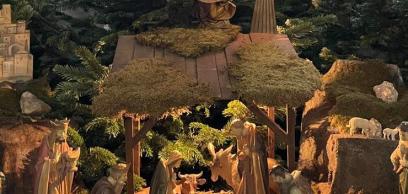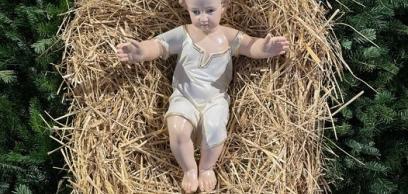Holy Masses in the Cathedral: on every Sunday and on holidays falling on weekdays at 10:30, on weekdays at 7:00.
Visitation of the Cathedral:
In summertime (March-October) between 8:00-18:00.
In wintertime (November-February) on workdays between 8:00-18:00 ask for the Cathedral to be opened at the reception of the Archdiocese.
Contact: +40-743-111-490 – Saltelechi Robert.
To make an appointment for guided tours and disabled access, please call +40-258-811.602 or contact via email on visit@romkat.ro.
Tower visit fee: 8 RON for adults and 4 RON for children.
History
The Diocese of Transylvania have been founded by Stephen I of Hungary around 1009 and its centre have been located in the Fortress of Alba Iulia. The original cathedral, the so-called I. Cathedral of the 11th century, have been a basilica with three naves and one semicircular apse. This shape did not remain in its original form, only the coloured lines on the floor mark its former existence.
The original building has been modified after the turn of the 12th-13th centuries to its present look, with the same basilical layout, but in a bigger space. This later cathedral has a Latin Cruciform transept with three naves, two southern towers and a spire crossing. The two secondary apses originally integrated a semicircular sanctuary.
The currently called old sacristy on the southern side, the Lászai Chapel (1512) and the Várday Chapel (1524) on the northern side were built later to the building. From 1565 to 1715 (with an interruption between 1594 and 1603) was used by Protestants. In 1916 it became Catholic again and since that year it is the seat of the Roman Catholic Archdiocese of Alba Iulia.
It is decorated with the figures of Hungarian saints (1728). At the front, the West gate opens in early Gothic style (circa 1270).
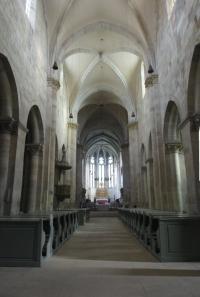 In the Southern side-aisle, close to the entrance, there is a Renaissance staircase with the shield of Bishop Ferenc Várday (1512-1524). Close to that can be found fragments of obituary monuments: János Hunyadi (†1456), his brother, János Hunyadi Jr. (†1442) and his son László (†1457), alongside those of Ferenc and Antal Kendi (both murdered in 1559).
In the Southern side-aisle, close to the entrance, there is a Renaissance staircase with the shield of Bishop Ferenc Várday (1512-1524). Close to that can be found fragments of obituary monuments: János Hunyadi (†1456), his brother, János Hunyadi Jr. (†1442) and his son László (†1457), alongside those of Ferenc and Antal Kendi (both murdered in 1559).
The ”Maiestas Domini” tympanum is one of the most significant fragments of engraving that remains from the first cathedral, and it was subsequently placed into the tympanum of the southern doorway. Its style tells us it was made at the end of the 11th century.
The so-called old sacristy resulted from the enlargement of the second cathedral at the beginning of the 13th century. When it was built, the original semicircular baptismal chapel was destroyed, leaving only a semicircular apse elevation standing out of the floor.
In the 17th century, Alba Iulia’s prebendary chapter was keeping the main certification archives of Transylvania and the princely library in this space.
The transept was built in the 12th century, as being part of the 2nd cathedral. The construction of its spire crossing arches was most likely to have been completed after the 1241 Tartar devastations. The southern facade of the transept is decorated by a rose window.
The main sanctuary of the cathedral was built in different time periods. At the beginning of the 13th century the square of the actual sanctuary was closed by a semicircular apse, rebuilt and broadened in gothic style at the end of the 13th century.
The main altar and pulpit are late baroque style and were made by Hoffmeyer Simon from Cluj Napoca (between 1783-1784) at the request of Bishop Batthyányi Ignác. Along the sanctuary’s sidewalls there can be found two six-seated, late baroque prebendal stalls, made in 1744 at the request of Bishop Klobusiczky Ferenc. The cornice of the stalls has seven busts on each side, representing the twelve apostles, respectively Jesus and the Virgin Mary. On the richly decorated seat backs are 12 scenes from the Old Testament from the Fall of mankind, until John the Baptist.
The so-called new sacristy (circa 1728) has a decorated Baroque portal opening towards the right side of the sanctuary.
The Várday-chapel is the result of an extension built in the first decades of the 16th century. The shield with the wolf fangs of the sounder, a relative of the Báthory family, was carved on the northern supporting pillar of the chapel. This shield can also be found on the Várday-stairway, under the western upper circle. The chapel floor shows tombstones of two ancestors of the Széchy-family, Transylvanian bishops András (†1356) and Domokos (†1368), of Czudar Imre (†1389), respectively the tombs of queen Izabella and her son, prince János Zsigmond made around 1571.
The walls hold epitaphs of architects and fortification designers Giovanni Morando Visconti (†1717) and Francesco Brilli (†1719), and also modern memorial plaques of cardinal Martinuzzi (Fráter) György (killed in 1551), and of principalities Bocskai István (†1606) and Bethlen Gábor (†1629).
Transylvania’s earliest Renaissance building in Transylvania is the Lászai chapel. It was built from the cathedral’s Romanesque portico in 1512 by canon Lászai János for the altar of the Souls of the Faithful Departed.
The façade of the chapel, modelled in northern Italian Quattrocento style, is inscribed with the poetic forms of an elegiac couple for knowledgeable humanists to decipher. It displays the shields of the chapel founder’s deceased and living patrons (kings Mátyás and II. Ulászló; popes Iulius II. and Leo X.; Bakócz Tamás, the archbishop of Esztergom; Geréb László; Transylvanian bishops Bachkai Miklós and Perényi Ferenc; palatine Perényi Imre; of the chief administraters of Transylvania Szapolyai János and Barlabási Lénárd), respectively shields of his humanist friends and relatives (canon Barlabási János; Wolphard Adorján; Budai Udlarik; Sánkfalvi Antal, the bishop of Nyitra) which are today barely decipherable.
Exterior decorations of the chapel bring up biblical figures of classical mythology and reliefs of canonised Hungarian kings.
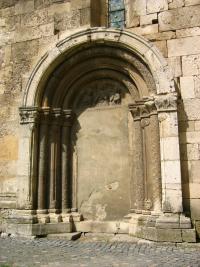 On the facade of the cathedral’s northern side, towards the eastern sanctuary, one can see a number of Romanesque style built-in statues [17], following the northern side-apse.
On the facade of the cathedral’s northern side, towards the eastern sanctuary, one can see a number of Romanesque style built-in statues [17], following the northern side-apse.
Here it will be noticed how the sanctuary’s northern facade bears distinctive elements of original Romanesque construction and of early Gothic extensions.
Above the sanctuary’s buttresses, which surround the entrance to the crypt, can be found Romanesque bas-reliefs.
These carvings were originally decorating the late Romanesque sanctuary and subsequently were placed above the buttresses in the mid-18th century: representations of two angels, the birth of Jesus, the three Kings scene, as well as a figurative series of animal and beasts in bas-reliefs from the main cornice frieze.
